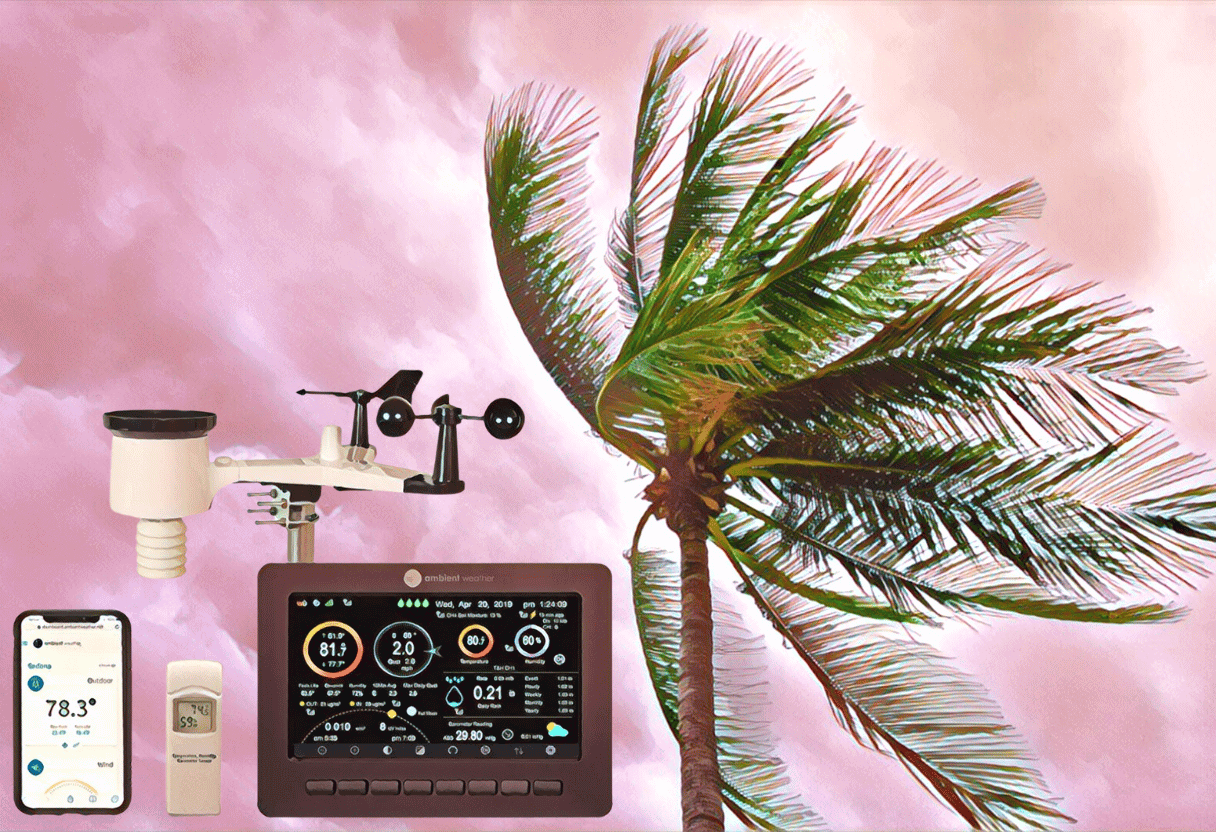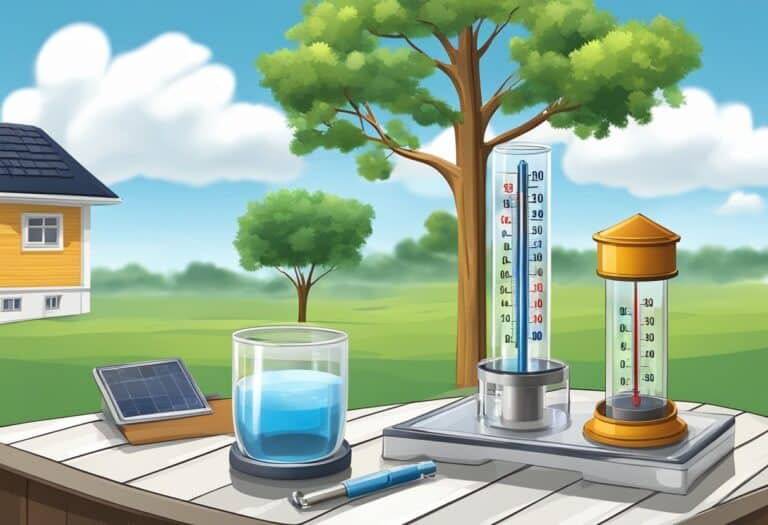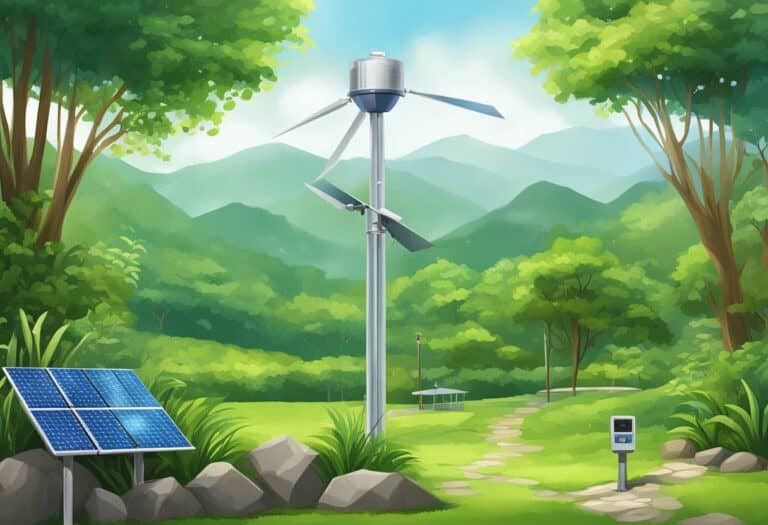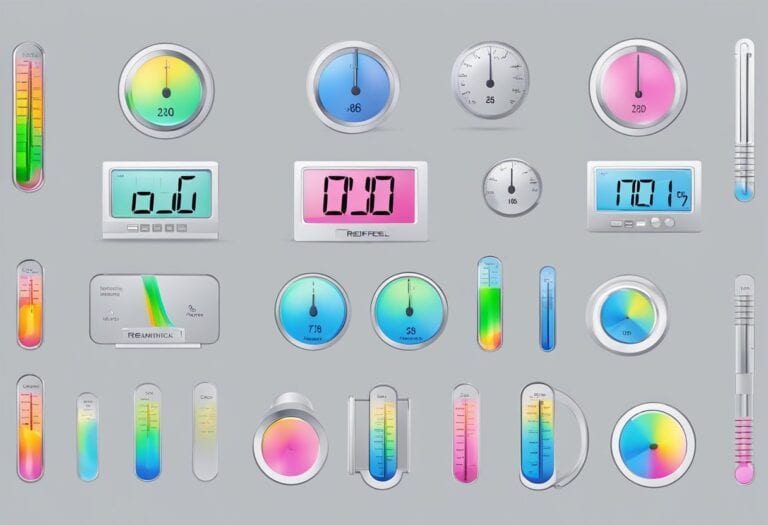Are you in search of the ultimate home weather station to transform your backyard into a meteorological wonderland?
The Ambient Weather WS-2000 Smart Weather Station might just be your ticket to understanding the whims of Mother Nature right from your doorstep. This device not only serves as a window to the atmospheric soul but also doubles as an aesthetic enhancement to your living space with its vibrant TFT color display.
Well, we’ll be going over:
- What sets the Ambient Weather WS-2000 apart from its competitors in terms of features and performance?
- How user-friendly is the WS-2000, and what can you expect during the setup process?
- In the long term, is the WS-2000 a worthy investment for both weather enthusiasts and the average homeowner alike?
With accurate weather readings just a glance away, getting ahead of Mother Nature has never been easier.
Let’s dive in.
Quick Review
For weather enthusiasts or anyone seeking to have detailed climate information at their fingertips, the WS-2000 is a solid pick.
Its array of sensors, user-friendly interface, and Wi-Fi capabilities make it a valuable tool for any household.
Interested in precise weather tracking? Click here to buy the Ambient Weather WS-2000 Smart Weather Station on Amazon and stay informed about the elements around you.
Overview of the Ambient Weather WS-2000 Smart Weather Station
Having spent some time with the WS-2000 from Ambient Weather, I’ve grown to appreciate the in-depth weather data it provides right from my backyard. The vibrant TFT color display is an eye-catcher that clearly shows the weather conditions. Moreover, the integrated sensor array is impressively comprehensive, measuring not just the basics like temperature and humidity, but also wind speed, direction, UV, and solar radiation. Plus, the inclusion of a rainfall gauge adds a nice touch for complete weather monitoring.
The setup is fairly straightforward and has enhanced Wi-Fi connectivity that pushes weather updates to your devices or the world’s largest personal weather station network. However, it’s worth noting that the sensor array relies on AAA batteries, which you’ll need to provide.
During my use, I noticed a few kinks, such as the need for occasional calibration and a rain gauge that may need careful maintenance. The price point may feel a bit high, but given the array of features and real-time data access, it’s understandable. The unit’s build is primarily plastic, which is sturdy enough but may require some protection from extreme weather.
In all, this weather station strikes a balance between detailed amateur meteorology and user-friendly design, making it a sound investment for weather enthusiasts looking for reliability without professional complexity.
Key Features
Having recently spent some time analyzing the Ambient Weather WS-2000 Smart Weather Station, I’ve walked away with a clear sense of its capabilities, strengths, and the minor areas where it could do better. Let me share my insights into the key features that make it stand out and the small quirks you might notice.
All-in-One Sensor Array
The integrated sensor array is the cornerstone of this device. Here’s what caught my attention:
- Measures a wide range of data: wind speed and direction, temperature, humidity, rainfall, UV, and solar radiation.
- The measurements have proven to be quite reliable, giving you a comprehensive overview of your immediate environment.
- Installation was straightforward, and the all-in-one design meant I didn’t have to juggle multiple components around.
Despite its comprehensive functionality, the unit requires 3 AAA batteries which aren’t included. Additionally, the sensor’s plastic housing, while durable, may not hold up in extreme weather conditions as well as some more rugged models.
TFT Color Display
The console’s TFT color display is a visual delight:
- Crisp, clear, and easy to read data presentations, even from a distance.
- The interface is intuitive, meaning I can toggle between data points without much fuss.
- The screen brightness is adjustable, which helps in different lighting conditions.
A minor drawback is that the display’s attractiveness doesn’t equate to outdoor visibility. On bright days, I found it tough to read the screen if I stepped outside to compare the conditions with the station’s readings.
Wireless Connectivity and Data Sharing
The station’s connectivity elevates its utility:
- The Wi-Fi connectability is enhanced, ensuring steady data transmission to weather station networks.
- I can check current conditions from my smartphone, which is a huge convenience for on-the-go updates.
- Sharing data is simple, making it a boon for weather enthusiasts who want to contribute to larger networks.
I should note, though, that initial setup can be a bit technical and may not be as accessible for those less familiar with wireless technology setups.
Customizable Alarms
The customizable alarms have proved to be very handy:
- I can set alarms for various weather thresholds, such as temperature or rainfall limits.
- This feature has been invaluable to me, especially in planning my gardening activities or deciding when to take cover from an impending storm.
Nevertheless, the alarms are only as good as the attention paid to them. No alarm can compensate for the human element of vigilance, so make sure to set them thoughtfully and check the console regularly.
In summary, the Ambient Weather WS-2000 is a well-rounded weather station, fitted with an impressive array of features. From its comprehensive sensor array and vibrant display to its robust connectivity options and practical alarms, it delivers an informative weather monitoring experience. It’s not without its small annoyances, such as the display’s sunny day readability and the need for technical prowess for the initial Wi-Fi setup, but these are minor when considering the overall reliability and functionality. I find it to be a solid investment for those passionate about meteorology or simply wanting a closer eye on their local weather patterns.
Pros and Cons
Pros
After spending some quality time with the Ambient Weather WS-2000, I’ve observed several positive aspects. Its TFT color display is particularly crisp and easy to read, which allows me to quickly glance at my home and backyard weather conditions without any fuss. The integration of wireless sensors that measure various data points including wind speed and direction, temperature, and even UV radiation is impressive, making it a comprehensive tool for weather enthusiasts like me.
I’ve also appreciated the unit’s capability to switch between imperial and metric units; it’s a small detail, but it shows that the designers considered users from different regions. The station’s enhanced Wi-Fi connectivity is a standout feature, enabling me to share data with a global network of weather stations, which is both fun and informative.
Operational wise, it’s been a smooth experience. The sensor array has been running on the same AAA batteries for months now, and the included 5V DC adapter ensures that I’m never out of juice on the console side.
Cons
However, the product is not without its downsides. I found the price to be a bit on the higher side, which might be a deterrent for casual hobbyists. I encountered a minor hiccup with setup, as the station couldn’t scan my Wi-Fi network initially, and I had to enter it manually. While this was a one-time issue, it could be a slight inconvenience for those less tech-savvy.
Moreover, while the device generally performs well, the rain gauge did stop working at around the year mark. Although it was possibly due to my mishandling, it’s worth noting for those considering this station. Another point to consider is the need to find a suitable mounting pole for the sensor array, which isn’t included and can be a bit of a puzzle to set up correctly.
Lastly, the sensor array’s requirement for AAA batteries means that you will need to keep spares on hand, although the need to replace them is infrequent. Overall, my time with the WS-2000 has shown that while it is an investment, its features and performance have mostly lived up to my expectations.
Ease of Setup and Use
From my experience, setting up the Ambient Weather WS-2000 was a smooth affair. The included instructions were straightforward, leading me through each step. Connecting the all-in-one sensor array wirelessly to the TFT color display console was intuitive and without hassle. I appreciated the wireless capability as it saved me from dealing with any messy cables.
Programming the device to my local Wi-Fi was pretty easy too, although I had to manually enter my Wi-Fi details because it couldn’t auto-detect the network. Once connected, my weather data began syncing seamlessly with the weather station network online, giving me access to real-time updates.
I’ll admit, figuring out the right mounting pole took a bit of thought, but that was more about my personal installation preference than any issue with the product itself. Early on, I ran into a snag with the rain gauge, which turned out to be a minor user error on my part that was quickly remedied.
It might be worth noting that while the console uses a provided 5V DC adapter, you’ll need to supply your own AAA batteries for the sensor array. I’ve only had to replace them once, and they weren’t even fully depleted at the time, which speaks to the unit’s energy efficiency.
Overall, though I found the price a bit on the higher end, the robust performance and the ease of both setup and daily use justified the investment. It’s been a reliable addition to my home, keeping me updated with precise backyard weather conditions.
Weather Monitoring and Data Accuracy
Having had the chance to experience the WS-2000 by Ambient Weather, I’ve gained a good sense of its capabilities in tracking backyard conditions. One of the first things I noticed is the all-in-one sensor array providing a wide range of data such as wind speed, direction, and even UV levels. The accuracy has been impressive, especially the temperature and humidity readings which align closely with local weather services.
I also appreciate the ability to personalize the system by calibrating the units of measure. It’s clear that Ambient Weather designed this to cater to weather enthusiasts looking for reliable data. The wireless connectivity is a huge plus, making remote monitoring a breeze and sharing data with weather networks is straightforward, thanks to the enhanced Wi-Fi options.
It’s not perfect, though. For instance, the rain gauge required some troubleshooting after a year, indicating a bit of maintenance might be necessary. But overall, the precision and reliability make the WS-2000 an ally in my daily weather observations. The system’s sturdiness and ease of setup are commendable, although I must admit the initial setup can be a bit daunting if you’re new to personal weather stations.
Customer Reviews
In using the Ambient Weather WS-2000, I’ve noticed it stands out for reliability. Many users, including myself, have experienced a seamless operation. The sensor array is robust, requiring minimal maintenance; I replaced the lithium batteries only once, and they hadn’t even been depleted. Some hiccups do occur, like an issue I had with the rain gauge, which stopped working after a year. But on closer examination, I suspect it was more user error than product fault.
A considerable number of customers found the setup process straightforward. I found that while the station couldn’t scan my WiFi automatically, manual input quickly solved the problem, and it functioned without a hitch afterward. Although mounting can require a bit of planning, it’s not insurmountable and is well worth the effort for the quality of data provided.
Conversations around price point vary. For me, the investment reflects the value, as the weather station offers a comprehensive suite of tools that satisfy even the most enthusiastic weather watchers, with timely updates and alerts right to my phone. While some believe the price leans towards the higher end, the consensus often circles back to the satisfaction with the product’s performance.
Conclusion
After spending significant time with the Ambient Weather WS-2000, I’ve been largely impressed by its robust performance.
The device’s sensor array has proven to be reliable, requiring minimal maintenance—a simple battery change after several years that wasn’t even a necessity. The weather station is easy to set up, despite a hiccup with Wi-Fi connectivity which required manual input of network details.
One drawback I’ve noted is the rain gauge’s durability; it stopped working after around a year, which might be attributed to user mishandling rather than a product flaw. The price point may raise eyebrows, yet I found the quality of data and the convenience of remote monitoring via Wi-Fi to justify the investment.
The lack of a battery option for the data collector is a limitation for some setups, but it does not detract significantly from the overall utility this weather station provides. Overall, it’s a sturdy addition to any weather enthusiast’s arsenal.
Frequently Asked Questions
In my time with the Ambient Weather WS-2000 Smart Weather Station, I’ve come to appreciate its robust features and the detailed attention it provides in monitoring local weather conditions. However, like any sophisticated device, users may have questions about setup, maintenance, and functionality. Below, I’ve addressed some of the more common queries based on my hands-on experience and research.
How do I set up my Ambient Weather WS-2000?
Setting up the WS-2000 is a process I found to be pretty straightforward. Initially, you need to install the outdoor sensor array, which involves selecting a location that’s free from obstructions for accurate data. I mounted mine clear of overhangs and tall structures. After this, power up the console with the provided DC adapter. Your task then is to connect the console to Wi-Fi; this enables data sharing with Ambient Weather’s online network. My advice is to follow the manual to ensure connectivity and data accuracy.
What are the common troubleshooting steps for the WS-2000?
From my experience, troubleshooting generally begins with checking power sources; ensure the console and outdoor sensor array have sufficient power. If you find connectivity issues, resetting the console and confirming Wi-Fi settings often resolves the problem. Sensor malfunctions are usually fixed by checking the unit for debris or repositioning it to improve data transmission. Also, replacing batteries periodically in the sensor array ensures uninterrupted service.
How accurate are the readings on the Ambient Weather WS-2000?
The accuracy of the WS-2000’s readings has impressed me overall. Temperature, humidity, and wind readings closely match up with local official readings when the sensors are properly sited and maintained. Calibration options are available, which I recommend tweaking to refine accuracy. However, occasional anomalies may occur with the rainfall measurement, similar to other personal weather stations I’ve used.
What is the difference between the WS-2000 and WS-5000 models?
While both models provide comprehensive weather data, the WS-5000 is an upgrade to the WS-2000 with additional features. The WS-5000 has enhanced sensors for even more precise data and offers expansion capabilities to include more sensors than the WS-2000. Having used the WS-2000, I can say it’s a highly capable model on its own for hobbyists and weather enthusiasts, but the WS-5000 is the better choice for those desiring the most advanced technology.
How long can I expect my WS-2000 weather station to last?
Throughout my use, the WS-2000 has proven to be durable. The station’s construction with plastic material is well-suited for continuous outdoor exposure. I’ve seen feedback from users reporting several years of reliable operation. To maximize longevity, periodic maintenance such as cleaning sensors and replacing batteries is necessary, reflecting my personal routine care practice.
Where can I find the manual for the WS-2000 weather station?
I located the manual for the WS-2000 on the Ambient Weather website. It’s available for download in a PDF format, which is convenient. Alternatively, the manual often comes included in the package, but in case it’s misplaced or one prefers a digital version, the Ambient Weather website is the best resource to retrieve it.







